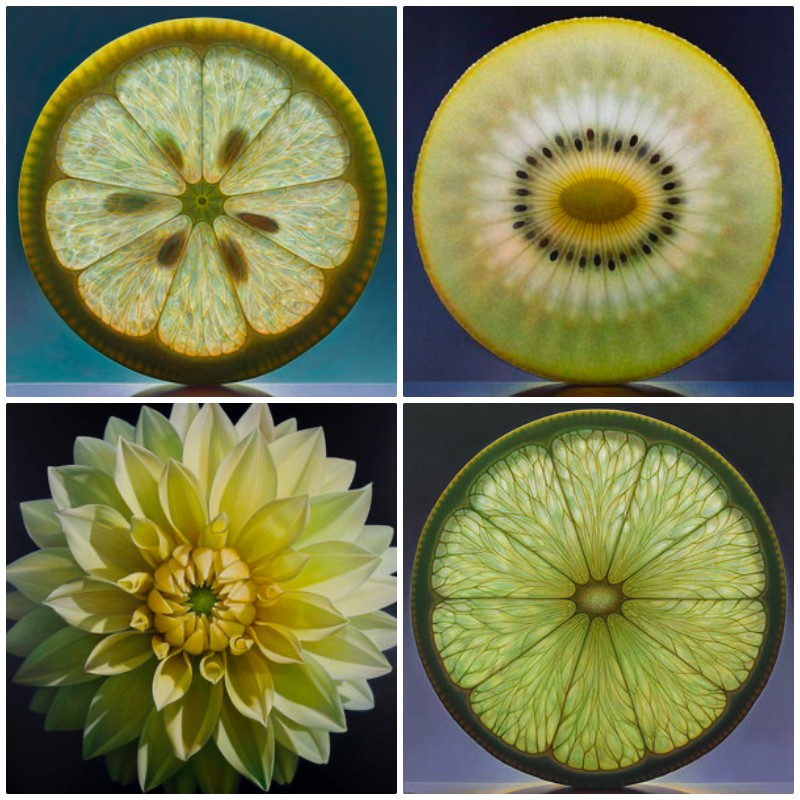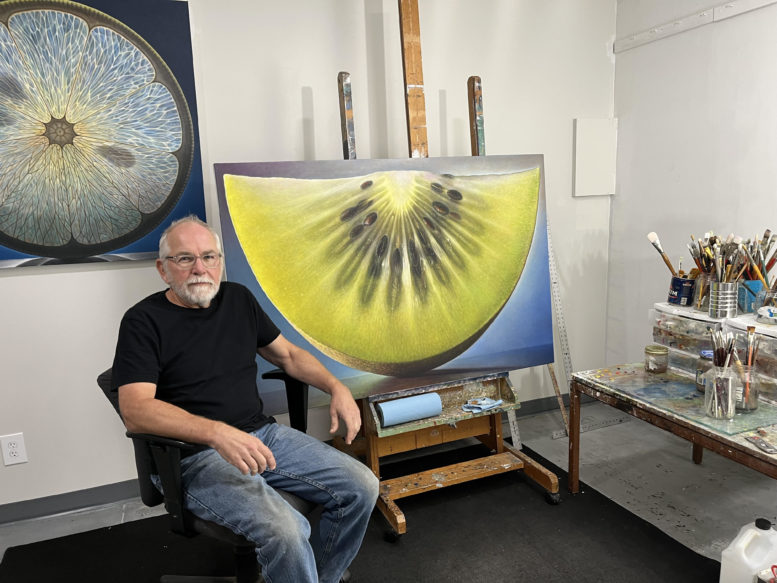Art professor retires from teaching to spend more time working in his studio
By DAVID DUPONT
BG Independent News
Dennis Wojtkiewicz could have ended up supervising grocery store managers.
The son of an A&P store manager, he showed talent for arranging produce when he was working as a substitute manager during the summers while in college.
The company took note of his talents and offered him a job as a supervisor. “This could be good money, a career,” Wojtkiewicz thought. “It’s good thing I decided to stay broke.”
Instead, he continued on his path to becoming an artist, and his paintings of produce, specifically fruit, have gained him a name in the art world.
Modern Met said he “creates large-scale oil paintings of fruit that look so real, they might make you want to reach into the canvas and take a bite. From mouthwatering citruses to succulent watermelons, the artist’s photorealistic paintings encapsulate each fruit’s form, texture, and delicious details.”

“If I’m known for anything it’s for them,” Wojtkiewicz said earlier this year. He’s represented by galleries in London, Chicago, and Tulsa. “I have enough people out there to support me out there in my work. I just need to make some work.”
That’s just what he plans to do.
Painting got him that steady paycheck – he was a professor of art at BGSU from 1988 until his retirement at the end of the fall, 2022 semester.
That was many years of teaching full-time then heading to his studio to paint for another four hours. “I could get into my studio at night when I was younger,” he said. “I could carve out hours. I could do 80 hours a week, 100 hours a week. I can’t do it anymore. In the evenings, I’m done. … I always fancied the idea of going into the studio fulltime unencumbered by other things.”
Wojtkiewicz, 66, had an unlikely start as an artist. He grew up in a working-class neighborhood in Chicago where tradespeople, police officers, and firefighters lived. “It’s like an island where all your friends and relations were. … It couldn’t be further away from the arts.”
He went to public school, and took art. He didn’t know what to do after graduation, but inspired by his high school teacher, he decided maybe art education was something worth considering.
He didn’t have any sense of the art world. Despite being in Chicago, he didn’t visit the Art Institute of Chicago aside from a few school excursions. “I didn’t understand a lot,” he said. “I was really naïve.”
Wojtkiewicz enrolled in the University of Southern Illinois. It “was as far away as I could get from my parents and still pay in state tuition. It was a five-hour drive so no one was popping in.”
Despite low in-state tuition, he still didn’t have any money. His father worked for A&P and his mother as a housewife. They had five kids and lived in a small flat. So, Wojtkiewicz did a variety of jobs. He worked at the A&P, did construction with an uncle, and, through a neighbor, got a job on the Cubs grounds crew.
At the end of his first year in college, he was considering dropping out because of a lack of funds. But his painting professor Bob Paulson, a legendary figure at the school, urged him to stay. “I don’t know what the hell he saw in me because I was a knucklehead, but I worked hard,” Wojtkiewicz said. “I understood work.”
If he left school, he would never come back, Paulson told him, so he arranged for a full scholarship for Wojtkiewicz. It still meant working summers and scrapping by.
And he discovered the work of Richard Estes, a central figure in photorealism painting. His work of city street scenes was so detailed and finely rendered, they look like photos. “This is what I want to do,” Wojtkiewicz told Paulson, who was trying to nudge him in another direction.
“I can’t teach you how to do this,” Paulson told him. “But I know a guy who can.”
That guy was Patrick Betaudier, a Trinidadian painter who had taught at Southern Illinois, but left because he was frustrated by the academic bureaucracy. He went to Paris where he founded Atelier Neo-Medici that focused on teaching the techniques of the Old Masters.
“I was fish swimming upstream” against the current of abstraction and experimentation, Wojtkiewicz said. Realism was seen as “too easy, too simple.” Artists were exploring their inner selves.
“I wanted to paint stuff that would ‘wow’ people, and coming from where I came from, I wanted the people I grew up with to be able to look at the work and appreciate it on their own terms.”
Thanks to credits he earned in high school, Wojtkiewicz graduated in three years in 1977, and he received a prestigious fellowship given to graduating seniors. He envisioned buying a car and a stereo system; Paulson urged him to use the money to spend a year in Paris studying with Betaudier.
For Wojtkiewicz, who had never been on a plane, who had never left the Midwest, the idea of spending a year in Paris was daunting.
In the end, he went to Paris lived in a shambling old chateau. Betaudier had an extensive circle of students and admirers – writers, TV producers, musicians art patrons.
“It was an eye-opening experience,” Wojtkiewicz said. “I traveled throughout Europe.”
The art scene” was like rock ‘n’ roll back then. … The food I ate, the fashion, everything was revelatory.”
While there, he painted the interior spaces, and the way they were illuminated. “My work has always been about light in one way or another.”
After his year in Paris, he returned to Southern Illinois. He was 21. The time in Paris was not considered part of his graduate studies, so he spent another three years in graduate school. “I needed every bit of it,” he said.
He received his MFA in 1981. He moved back to Chicago to paint and did his academic rite of passage as an adjunct. He married fashion photographer Diana Dimas. They were well settled, so when Tom Hilty, then director of the BGSU School of Art, reached out about an open tenure-track position, he was hesitant. Hilty knew him because their work had been shown in the same gallery.
Wojtkiewicz took his time getting his application materials in, and he was the last candidate interviewed.
He was offered the job before he left campus.
Moving from Chicago where both he and Dimas have family and where they were comfortable was a sacrifice. Still, they settled in here at Bowling Green, and Wojtkiewicz has come to love the place. Even in retirement, he has no intention of leaving.
In his years at BGSU, the school developed a reputation as a place for representational, figurative, and narrative painting. Being conservative helped the university carve out a niche for itself among other programs. In 2019, he organized a traveling exhibit celebrating the school’s tradition of realism, featuring the work of his former students.
[RELATED: Realism comes into focus in BGSU traveling art show]
For a number of years, his mentor Betaudier came to campus to do summer workshops.
Wojtkiewicz’ work evolved over those years. He painted figures in the 1990s, he said, but got tired of the specificity required. The paintings were about who the subject was.
He began working on still life images. But, he said, he would see still life paintings in art magazines and think: “my name could be under every one of them”.
Then he sliced a lemon and saw how the light penetrated the flesh. It was an “a ha moment.” His paintings became simpler and focused on the interaction of the light and the flesh of the fruit.
Once he’d stripped his subject down, he knew he didn’t need to complicate it again. “I could just revel in the process.”
That glowing translucence is the result of layer upon layer of paint.
He begins with an initial image to lay out the composition. “Those edges are really important,” he said. “The tension of where that form sits in relation to the edges has to be just right. There’s a little bit of buzz that happens. … If the underpainting is a go that puts the odds in my favor.”
He thinks of the layers of paint that follow, the alternating tonalities of dark and light, warm and cool, as a series of corrections. “You keep complicating the thing.”
He moves the tone back and forth until he finds this equilibrium. “It’s supposed to light up in the end. That’s when I know I’ve been successful when the painting just lights up on its own.”
He keeps at it until he’s done – he completes about one painting a month. If it seems to be finished too soon, he doesn’t trust it.
Once done, he’ll turn the painting around, and not look at it for a few days, before viewing at it again to determine if it’s finished.
“You need fresh eyes sometimes,” Wojtkiewicz said. His wife, he said, is “my best critic.”
This is what he wants to continue doing now that teaching is behind him. “I want to get to my studio and paint and put shows together again. I still have the energy and enthusiasm when I get into my studio.”
He recalls Betaudier, who died in 2008, at one of his summer workshops. He was sitting at the easel with students around him. He was very much an entertainer, Wojtkiewicz recalls.
“He turns to the students and says: ‘I’m finally starting to figure it out.’”
That sentiment resonates with Wojtkiewicz. “This idea that you can be surprised, that you never figure it out and that there’s always something new ahead. Even if I’m working with the same subject matter, there’s a way to see it anew, a way to see the same thing but it’s different. With being engaged on a steadier basis that’s what I’m looking for, to see what happens.”

